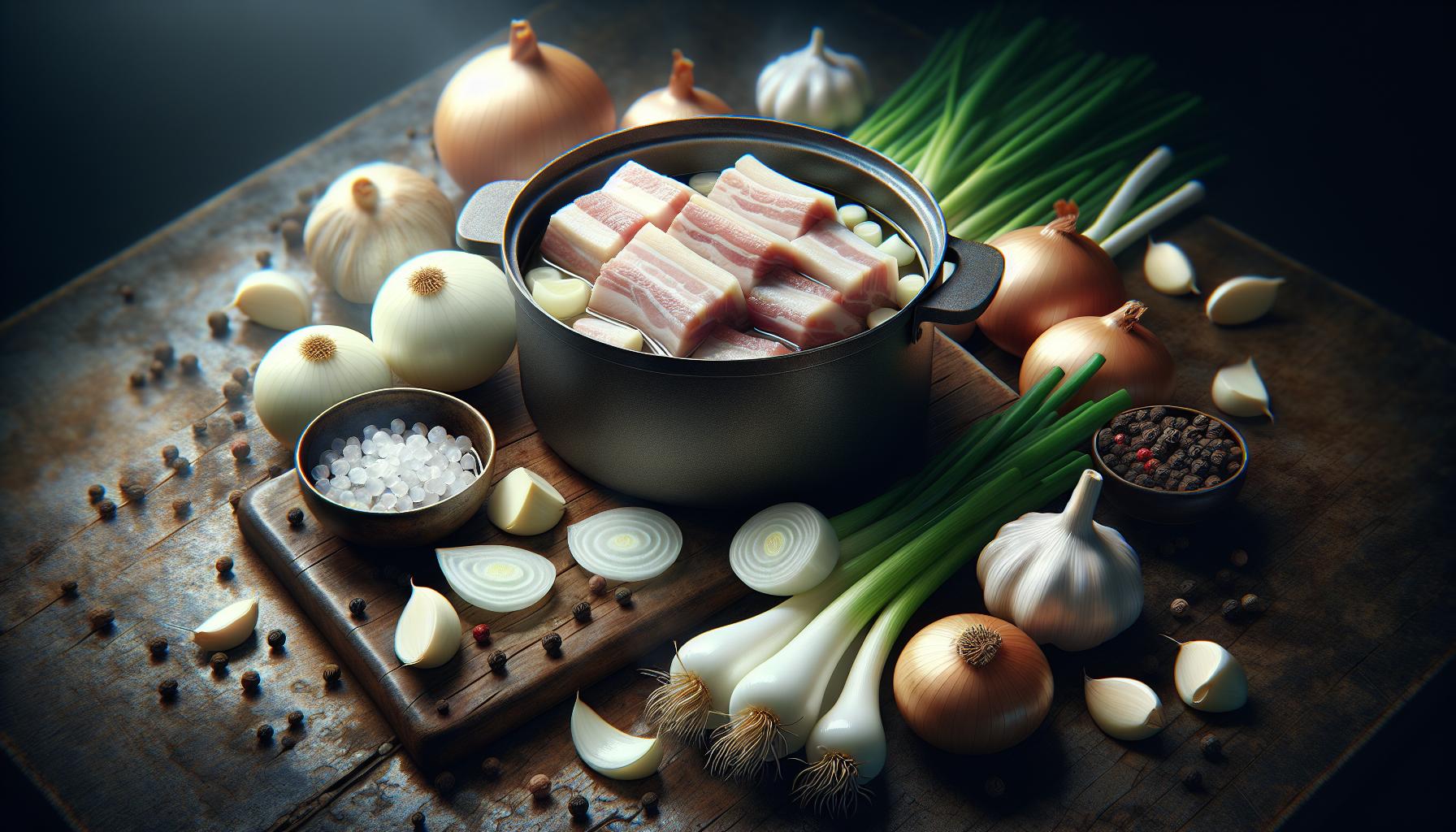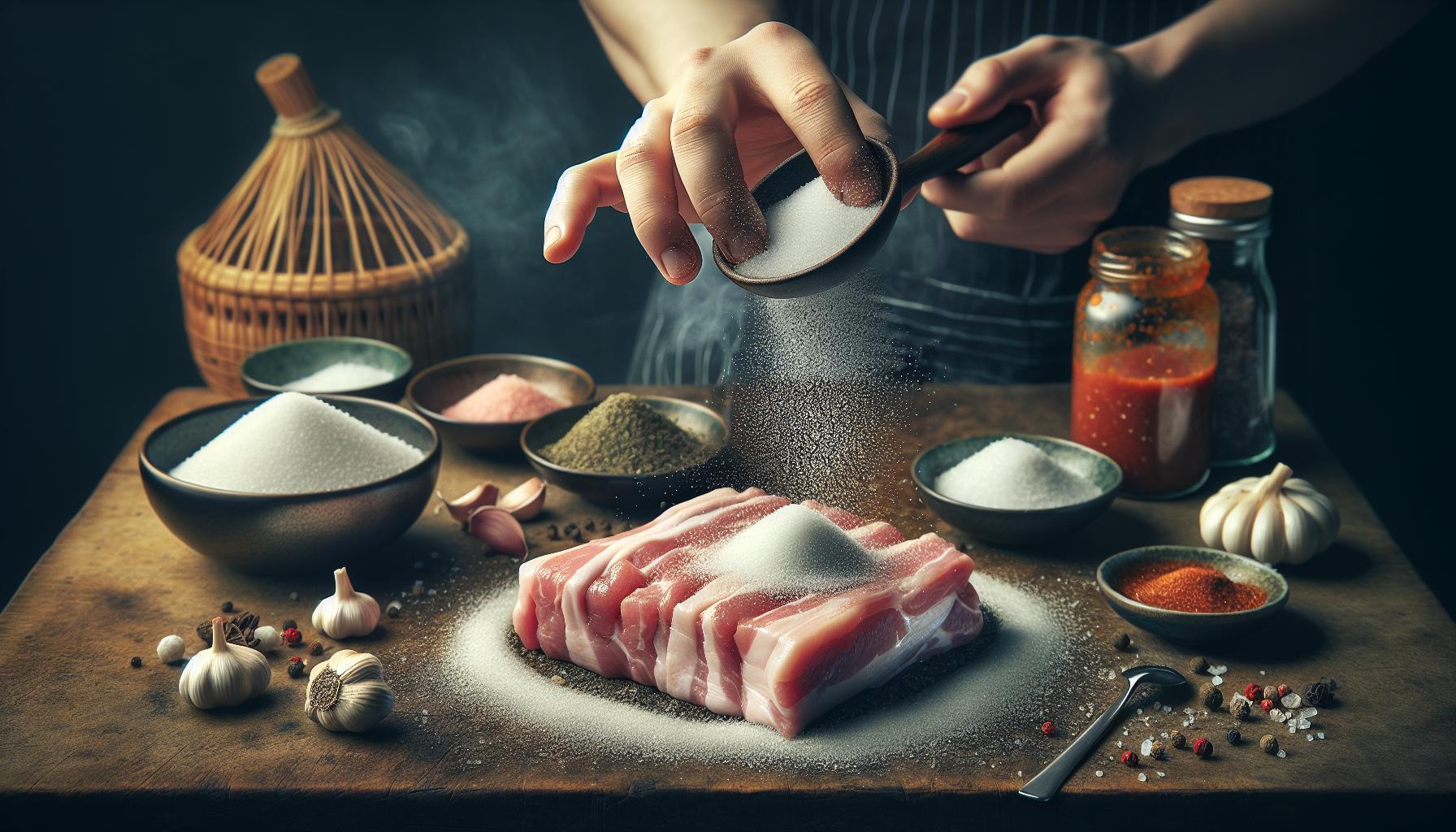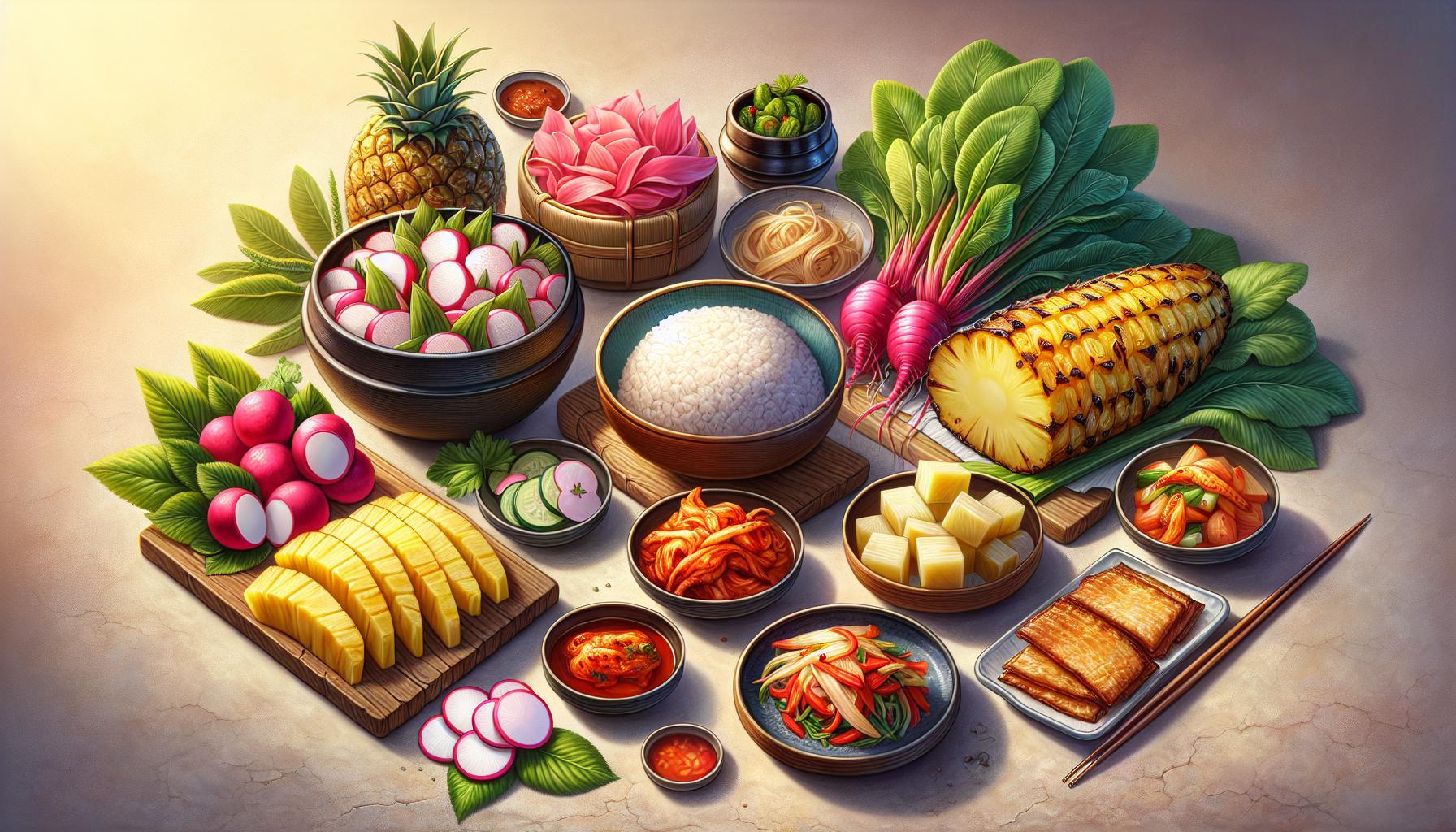Ingredients for Homemade Korean Boiled Pork Belly Bossam
Products from your local butcher and greengrocer are staples in any good kitchen. When you embark on cooking a dish like Korean Boiled Pork Belly Bossam, quality matters. Let’s explore the fine selection of ingredients that’ll make your dish come to life.
For the Pork Belly:
To start off, you’re going to need a good sized piece of pork belly. For the recipe we’re showcasing, 1.5 kg of pork belly works perfectly. This cut of meat ensures a tasty, juicy result every time.
For the Broth:
Creating a flavorful broth really enhances the overall taste. For this, you have to source 2 liters of water, 1 cup of soy sauce, and 1 cup of rice wine. You’d also need 1 chopped onion, 1 chopped leek, 10 crushed garlic cloves, and 2 tablespoons of ginger. Add to these, 2 teaspoons of black peppercorns and a cup of instant coffee. Yes, you read it right! Coffee. It’s an unconventional ingredient that provides a distinct, memorable kick.
For the Wraps and Sides:
Apart from the pork belly and broth, bossam also comprises fresh sides and wraps. To start, stock up on 2 heads of well-rinsed fresh lettuce and perilla leaves. You will also need a jar of pickled radish, a Korean staple.
Retailoring the Recipe:
For those with a penchant for more flair, try adding thinly chopped chilies to your broth. Perhaps a hint of sweetness? A dash of honey might just do the trick.
If you’re curious about the nutritional value of this exquisite dish, it’s a superb blend of essential macros.
| Ingredient | Calories | Carbs | Protein | Fat |
|---|---|---|---|---|
| 1.5 kg Pork Belly | 4,312 kcal | 0 g | 300 g | 312 g |
| Soy Sauce | 40 kcal | 8 g | 4 g | 0 g |
| Rice Wine | 25 kcal | 5 g | 0 g | 0 g |
| Lettuce | 5 kcal | 1 g |
Step-by-Step Guide to Boil the Pork Belly

Boiling the pork belly may seem daunting. Relax. It’s easier than you might think. Just follow these steps. You’ll achieve culinary bliss in no time!
To begin, grab your quality pork belly. It should weigh around 1.5 kilograms. The size matters. It influences how much fat renders out.
Next, prepare the broth. Culinary experts emphasize a broth’s role in a dish’s taste. It’s the secret ingredient infusing the pork belly with flavors. So, pay extra attention.
Let’s get started.
- In a large pot, combine 7 cups of water, 1 cup of soju (a Korean spirit), half a cup of coffee, half a cup of doenjang (a fermented Korean soybean paste).
- Add 2 onions, 2 heads of garlic, a handful of scallions, and 10 black peppercorns.
- For heat lovers, feel free to add 2 chopped Korean chili peppers. Not a fan of spicy foods? Simply skip this part.
Once you have all your ingredients in the pot, it’s time to introduce the pork belly. Make sure it’s submerged in the broth. Adjust the ingredients accordingly.
Turn on the heat. Let the broth come to a boil. Then, reduce it to a gentle simmer. This slow cooking process is crucial for tender, succulent pork belly. It allows the flavors to penetrate deep into the meat. So don’t rush it.
The boiling should take roughly 1 hour and 30 minutes for 1.5 kg of pork belly.
While you wait, don’t forget to skim off any impurities that float to the surface. It keeps your broth clear and clean-tasting.
And there you go. That’s how to boil the pork belly. But don’t stop here. Keep exploring. There’s still the assembly of the Bossam dish awaiting you. The combination of various ingredients like lettuce, perilla leaves, and pickled radish will surely open up a new world of flavors.
The nutritional breakdown of the dish, based on 1 serving, is as follows:
| Nutrient | Amount |
|---|---|
| Calories | 560 kcal |
| Carbs | 9 g |
| Protein | 12 g |
| Fat |
Preparing the Seasoning for the Pork Belly

Turning our focus to the seasoning, the essence that infuses the pork belly with a flavor explosion, you’ll want to start off by procuring these key ingredients. Gather 2 tbsp sugar, 2 tbsp salt, 2 tbsp black pepper, and 1 tbsp garlic powder. This balance of sweet, salty, spicy, and garlicky contributes to the complexity of the Bossam taste profile.
To prepare the seasoning, first mix all the ingredients in a bowl. This ensures even distribution of flavors over the pork. Following this, you’ll need to apply the mixture all over the pork belly. Rub it in properly so it penetrates the meat, reaching every corner.
A fun fact: several significant Bossam chefs swear by adding a slight hint of cinnamon to the seasoning. This unconventional twist subtly enhances the flavor of the dish, giving it a unique spice backdrop that sets it apart from an average Bossam. So, if you’re daring and in the mood for a culinary experiment, add a quarter teaspoon of cinnamon to your seasoning mix!
The nutritional breakdown of the seasoning per serving pans out as below:
| Element | Value |
|---|---|
| Calories | 25 kcal |
| Carbs | 6g |
| Protein | 0.8g |
| Fat | 0.1g |
The next step: slathering the meat with Gochujang, a savory and pungent fermented Korean condiment made from red chili, glutinous rice, fermented soybeans, and salt. Its robust flavors and mild heat will earn it a special place in your heart!
The infusion of these seasonings is a pivotal step in the Bossam-making process as it breathes life into the dish. Take your time to let the flavors sink in before moving to the next stage of the cooking process. Embrace this segment with patience, it takes you one step closer to crafting an authentic, homemade Korean boiled pork belly Bossam dish.
How to Assemble the Bossam Wraps

You’ve marinated your pork belly and it’s seeping with authentic, luscious Korean flavors. Now the fun part begins – let’s get those bossam wraps assembled!
Start by laying out a fresh lettuce leaf in your hand. You’re looking for a balance between size and tenderness; too small and you won’t fit your fillings, too large and it could overbear the flavor palette. Grab a piece of that juicy, flavorful pork belly you’ve seasoned, and place it in the center of your lettuce leaf.
The art comes in choosing your fillings. Traditional bossam wraps often include thinly sliced garlic and spicy pepper. You could also add a slice of fresh kimchi, delivering that tangy heat bossam wraps are known for. Then, for an unconventional yet tantalizing addition, consider some thinly sliced pear or pineapple. The fructuous sweetness punches through the savor of the pork and spice, providing a captivating contrast that sets your homemade Korean boiled pork belly bossam apart!
Once your fillings are chosen and added, delicately fold the lettuce leaf to encase the ingredients. You’ve mastered the light touch needed. Over-stuffing could see the wrap tear, too scanty and you lose out on the flavor feast. The perfect bossam wrap achieves a harmony of flavors in each bite.
List of ingredients and their amount needed per wrap:
- Fresh lettuce leaf: 1 large
- Marinated pork belly: 1oz
- Thinly sliced garlic: To taste
- Spicy pepper: To taste
- Fresh kimchi: 1oz
- Thinly sliced pear or pineapple: 1 slice
Remember, creating and enjoying bossam wraps is an experience. It’s not just about feeding your stomach – engage your senses! From the textures of the ingredients, to the delightful contrast in tastes, it’s a culinary adventure to savor.
Nutritional value per wrap (approximate):
- Calories: 180
- Carbs: 10g
- Protein: 15g
- Fat: 9g
In your hands now is a bossam wrap packed with a world of flavor. Don’t let the journey end here! In the upcoming section, we’ll dive into side dishes that play perfect company to your homemade Korean boiled pork belly bossam.
Serving Suggestions and Tips

Pairing your homemade Bossam wraps with just the right sides can elevate your meal to a whole new level. It’s not just about taste, it’s about creating a gastronomic experience that’s truly delightful.
Start with a bowl of steamed rice. It’s simple, sure, but it provides a soft, soothing balance to the spicy, flavorful Bossam wraps. You’ll find that it complements the meaty taste quite beautifully.
Don’t forget your pickled radishes. This often overlooked side dish is a wonder when combined with Bossam. Its tangy flavor and crunchy texture adds a refreshing contrast to your wraps.
Another winner is kimchi. But we’re not just talking about any kimchi. Opt for aged kimchi – its deeper, more complex flavors make a world of difference.
Offbeat tip? Try grilled pineapple slices. It’s unconventional, but the caramelized sweetness of the fruit works wonders with the savory flavors of the pork belly.
Make sure you’re serving your wraps and sides at the right temperature. While the meat should be warm, the wraps and most of the sides are best served cold. It’s a unique ‘hot-cold’ combination that’s part of the Bossam experience.
Finally, here’s an important tip: don’t rush. Take your time to savor the textures, the flavors, and the experience itself. Each bite deserves your full attention.
Here’s a quick visual on the perfect pairings:
| Food | Ideal Pairing |
|---|---|
| Bossam Wraps | Steamed Rice |
| Bossam Wraps | Pickled Radishes |
| Bossam Wraps | Aged Kimchi |
| Bossam Wraps | Grilled Pineapple |
Remember, these are just suggestions. Feel free to experiment and find your own perfect pairings. After all, the beauty of home cooking lies in its endless possibilities.
Conclusion
You’ve now unlocked the secrets to an unforgettable homemade Bossam experience. It’s not just about the boiled pork belly, but the symphony of flavors and textures that come together in every bite. Remember, it’s all about balance – the soothing steamed rice, tangy pickled radishes, deep-flavored aged kimchi, and sweet grilled pineapple slices. Don’t forget the ‘hot-cold’ serving temperature combo for an added twist. So go ahead, let your taste buds lead the way and explore the endless possibilities of home cooking. After all, the beauty of making Bossam at home is the freedom to experiment and make it your own. Savor each bite and take your time to appreciate the harmony of flavors. Happy cooking!

